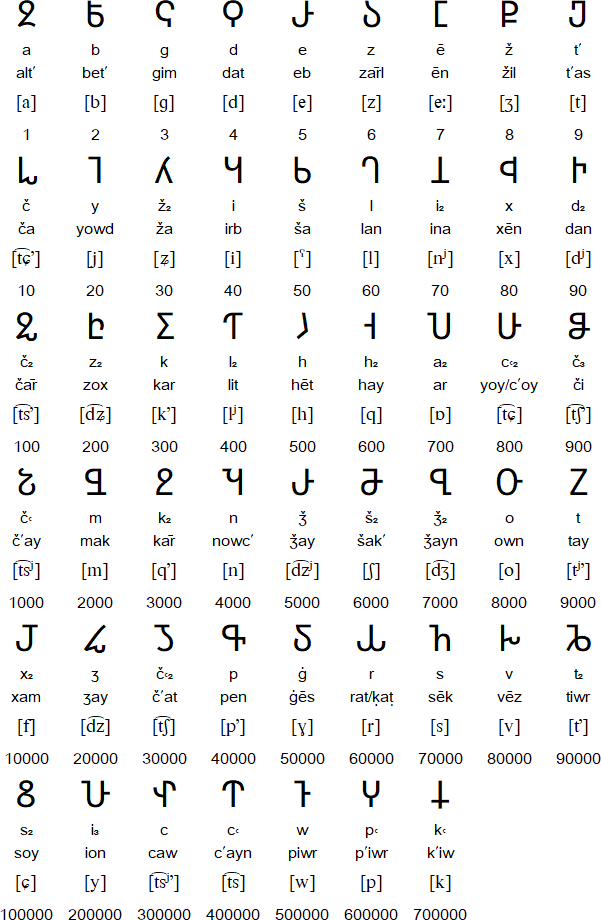The Caucasian Albanian alphabet, which is also known as the Old Udi script, was used by the Caucasian Albanians, speakers of a northeast Caucasian language who lived in parts of what is now Azerbaijan and Daghestan. The alphabet was mentioned in some early sources, and was rediscovered in 1937 by Professor Ilia Abuladze in an Armenian language manuscript dating from the 15th century. The manuscript contained details of alphabets such as Armenian, Greek, Latin, Georgian, Coptic and Caucasian Albanian, which was referred to as "Ałuanic girn e", which means "Aghuanic alphabet/writing" in Armenian. Professor Abuladze believed the alphabet was based on the Georgian alphabet.
Further examples of the Caucasian alphabet were found in the 1940s and 1950s in the form of short inscriptions on a stone altar post, and on candlesticks, tiles and vessels. In 2003 a longer text on a palimpsest was found in St. Catherine's Monastery on Mount Sinai in Egypt. They date from between the 4th and the 12th centuries AD.
Georgian scholars believe that King Pharnavaz I (ფარნავაზი) of Kartli (Iberia) created the Caucasian Albanian alphabet, probably in the late 4th or early 5th century AD, however Armenian scholars believe that Mesrop Mashtots' (Մեսրոպ Մաշտոց), an Armenian missionary, did so.
Udi, a northeast Caucasian language spoken in parts of Azerbaijan, Georgia and Armenia, is thought to be a descendant of the Caucasian Albanian language.
The name "Albania" is Latin for "mountaneous land" and the Caucasian Albanians were not related to the Albanians of Albania, nor were their languages related.

Download an Caucasian Albanian alphabet chart (Excel)
Some details provided by Mattias Persson & Josh Gippert
Information about Udi | Caucasian Albanian (Old Udi) script | Phrases | Numbers (Udi) | Numbers (Old Udi / Caucasian Albanian )
Information about the Caucasian Albanian alphabet and language
http://azer.com/aiweb/categories/magazine/ai113_folder/113_articles/113_zaza_aleksidze_ashes.html
http://en.wikipedia.org/wiki/Caucasian_Albanian_alphabet
https://en.wikipedia.org/wiki/Caucasian_Albanian_language
http://www.azerb.com/az-caucasian-albania.html
https://armazi.uni-frankfurt.de/sinai/albschr.htm
A-chik Tokbirim, Adinkra, ADLaM, Armenian, Avestan, Avoiuli, Bactrian, Bassa (Vah), Beitha Kukju, Beria (Zaghawa), Borama / Gadabuursi, Carian, Carpathian Basin Rovas, Chinuk pipa, Chisoi, Coorgi-Cox, Coptic, Cyrillic, Dalecarlian runes, Elbasan, Etruscan, Faliscan, Fox, Galik, Georgian (Asomtavruli), Georgian (Nuskhuri), Georgian (Mkhedruli), Glagolitic, Global Alphabet, Gothic, Greek, Hurûf-ı munfasıla, Irish (Uncial), Kaddare, Kayah Li, Khatt-i-Badíʼ, Khazarian Rovas, Koch, Korean, Latin, Lepontic, Luo Lakeside Script, Lycian, Lydian, Manchu, Mandaic, Mandombe, Marsiliana, Medefaidrin, Messapic, Mongolian, Mro, Mundari Bani, Nag Chiki, Naasioi Otomaung, N'Ko, North Picene, Novo Tupi, Nyiakeng Puachue Hmong, Odùduwà, Ogham, Old Church Slavonic, Oirat Clear Script, Ol Chiki (Ol Cemet' / Santali), Old Italic, Old Nubian, Old Permic, Ol Onal, Orkhon, Osage, Oscan, Osmanya (Somali), Pau Cin Hau, Phrygian, Pollard script, Runic, Székely-Hungarian Rovás (Hungarian Runes), South Picene, Sutton SignWriting, Sunuwar, Tai Viet, Tangsa, Todhri, Toto, Umbrian, (Old) Uyghur, Wancho, Yezidi, Zoulai
Page last modified: 18.07.23
[top]
You can support this site by Buying Me A Coffee, and if you like what you see on this page, you can use the buttons below to share it with people you know.

If you like this site and find it useful, you can support it by making a donation via PayPal or Patreon, or by contributing in other ways. Omniglot is how I make my living.
Note: all links on this site to Amazon.com, Amazon.co.uk
and Amazon.fr
are affiliate links. This means I earn a commission if you click on any of them and buy something. So by clicking on these links you can help to support this site.
[top]